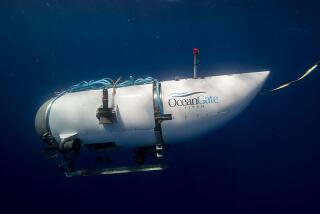Halifax Is No Stranger to Disasters
- Share via
HALIFAX, Canada — No other city in Canada is so closely tied to the sea by history and tragedy as this port of 332,000 residents chiseled into the stony Nova Scotia coast.
Halifax was the arrival port for millions of European immigrants to Canada for much of this century, the launch point for transatlantic Allied convoys in two world wars, the final resting place for 150 victims of the Titanic’s sinking, the site of a violent ship explosion that ranks as this country’s worst maritime disaster.
Its longtime status as one of the Atlantic’s premier deep-water ports and as a capital of the fishing industry has instilled in Haligonians, as residents call themselves, a deep sense of community and self-sufficiency.
Now, with the crash of Swissair Flight 111, a new chapter is being added to Halifax’s centuries-old relationship with the turbulent North Atlantic.
When the jetliner, bound for Geneva from New York, fell into the ocean down the coast near Peggy’s Cove late Wednesday, the region spontaneously wheeled into action. More than a dozen fishing boats motored to the crash scene; some were members of the officially organized Auxiliary Coast Guard, but others were unbidden volunteers. Anticipating survivors, they brought blankets and food, and one towed a raft.
Scores of other residents lined the shore hoping to help.
To Dan Conlin, curator of marine history at the city’s Maritime Museum, the mobilization came as no surprise. It marked a repetition of the drill that this area has perfected in dealing with more than 5,000 shipwrecks dating back to 1588. History’s first rescuers here were the area’s Micmac Indians, who helped save survivors of the wrecks of French and British warships in pre-colonial days. But the pattern was perfected by fishing families in isolated communities who were forced to rely on themselves in the days before helicopter-borne military rescue operations were the norm.
“These communities were really on their own when it came to rescuing themselves or strangers,” Conlin said in an interview in the museum library Friday. “This is not just historical. Fishing is still a dangerous profession. Every year fishermen are lost at sea. . . . Every family has lost a relative or knows someone who has had that experience.”
Halifax’s location as a strategically placed, ice-free, deep-water port, surrounded by fishing grounds that once teemed with cod and other species (badly depleted by overfishing in the last decade) has always defined the community.
From the 1920s until the late 1950s, Conlin said, the port served as the main processing center for immigrants, the Canadian equivalent of New York’s Ellis Island. The main difference between the two sites, except for the much greater volume of arrivals in the U.S., is that immigrants here, once processed, were quickly put on trains and moved to different parts of this sparsely populated country.
Halifax is situated along the main arc of the transatlantic shipping lanes (and today is below the path of European-bound flights from the eastern U.S.) and, so, was an ideal spot to assemble ship convoys during the wars.
But one of those convoy vessels was at the center of the city’s greatest trauma, an explosion in 1917 that killed an estimated 2,000 people. The ammunition ship Mont Blanc, loaded in New York but waiting in Halifax for the assembly of a convoy, blew up in the harbor after it was hit by another ship.
For Conlin, however, the response to Wednesday’s crash was most reminiscent of the sinking of the White Star passenger liner Atlantic on April 1, 1873. En route from Liverpool, England, to New York, the ship intended to stop in Halifax to take on coal. In heavy seas, it struck a reef that ripped out its bottom, then quickly rolled on its side and was swamped.
“In five minutes, its deck was awash,” Conlin said. “There was an incredible Darwinian struggle to survive. This was not women and children first.” Four hundred of the 1,000 people aboard survived: 399 men and one child.
That anyone lived was a tribute to the rescue work of Halifax-area residents, who risked their own lives in the rescue, Conlin said. Every fishing boat in Prospect, a village near Peggy’s Cove, helped out. Afterward, residents recovered bodies, 227 of which are buried in a recently restored cemetery.
There also are parallels between this week’s crash and the Titanic disaster. A Halifax-based cable repair ship, the Mackay-Bennett, was sent to recover bodies floating in the frigid ocean in April 1912 after the Titanic went down. Hundreds of bodies were returned here, and, as with the Swissair crash, relatives followed to identify the dead. The 150 Titanic victims buried here are generally those whose families could not afford to take them home for burial.
The Mackay-Bennett also returned with some debris from the Titanic, some of which is on display at the Maritime Museum.
Halifax residents continue to reach out. By Friday, more than 300 had volunteered to house, chauffeur or otherwise assist the relatives who have begun arriving to identify remains of the 229 crash victims.
More to Read
Sign up for Essential California
The most important California stories and recommendations in your inbox every morning.
You may occasionally receive promotional content from the Los Angeles Times.










